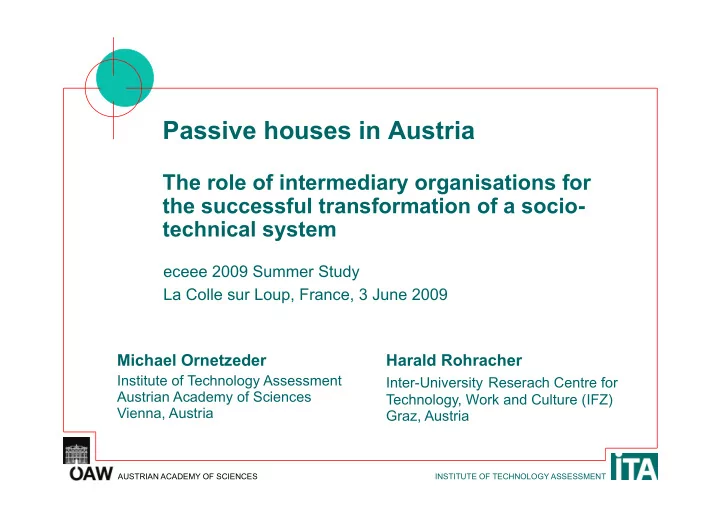

Passive houses in Austria The role of intermediary organisations for the successful transformation of a socio- technical system eceee 2009 Summer Study La Colle sur Loup, France, 3 June 2009 Michael Ornetzeder Harald Rohracher Inter-University Reserach Centre for Institute of Technology Assessment Austrian Academy of Sciences Technology, Work and Culture (IFZ) Vienna, Austria Graz, Austria AUSTRIAN ACADEMY OF SCIENCES INSTITUTE OF TECHNOLOGY ASSESSMENT
Introduction The building sector offers an enormous potential to reduce the energy consumption Case study on passive houses in Austria Dissemination of PH: A success story Socio-technical change in the building sector Focus on the role of intermediation Policy relevant question: How to support and facilitate socio-technical change towards more energy efficiency? AUSTRIAN ACADEMY OF SCIENCES INSTITUTE OF TECHNOLOGY ASSESSMENT
Intermediation Intermediation means to connect, translate and facilitate flows of knowledge Intermediary actors: work in-between, make connections, enable relationships etc. Intermediation plays an important role in processes aiming at the transition of socio- technical systems toward sustainability Multiplicity of actors Distributed Innovation Technology, social practices and institutions AUSTRIAN ACADEMY OF SCIENCES INSTITUTE OF TECHNOLOGY ASSESSMENT
Dissemination of PH (worldwide) Source: IG Passivhaus 2009 AUSTRIAN ACADEMY OF SCIENCES INSTITUTE OF TECHNOLOGY ASSESSMENT
Dissemination of PH in Austria Future prospects End of 2008: 4150 PH Source: IG Passivhaus AUSTRIAN ACADEMY OF SCIENCES INSTITUTE OF TECHNOLOGY ASSESSMENT
Passive houses in Austria Source: Lang 2004 AUSTRIAN ACADEMY OF SCIENCES INSTITUTE OF TECHNOLOGY ASSESSMENT
Development of the PH as socio-technical system Early set-up phase (1988-1996) Development of the socio-technical core First demonstration building in Germany in 1990 Establishment of the Passivhaus Institut in Darmstadt (Germany) Regional niche growth (1993-1999) Transfer of the concept to Austria (Province of Vorarlberg) Energy Institute Vorarlberg as central change agent (e.g. summer school, training programmes) First building in 1996, growing number of buildings, learning, practical experiences and feedback AUSTRIAN ACADEMY OF SCIENCES INSTITUTE OF TECHNOLOGY ASSESSMENT
4 overlapping phases Outgrowing the niche (1998-2005) First EU-project on passive houses (CEPHEUS) National R&D programme ’Building of Tomorrow’ More buildings (pilot-projects), new networks, new intermediary actors Institutionalisation and stabilisation (since 2001) New interest organisations focussing on PH PH linked to climate change, dissemination programme Growing influence on subsidy guidelines, building regulations, academic courses, vocational training... AUSTRIAN ACADEMY OF SCIENCES INSTITUTE OF TECHNOLOGY ASSESSMENT
Intermediation in the PH case Bottom-up process without central steering, high demand for intermediation Different types of intermediation activities Intermediation requirements change over time Intermediary functions taken over by different types of actors Already existing organisations & especially set up PH intermediaries Most of the intermediary activities were publicly funded AUSTRIAN ACADEMY OF SCIENCES INSTITUTE OF TECHNOLOGY ASSESSMENT
Discussion Intermediation (alone) does not explain the success of the socio-technical system Intermediation is relevant as entry point for public policy Funding: existing organisations Finding: intermediation gaps “Public governance through intermediation” What else? AUSTRIAN ACADEMY OF SCIENCES INSTITUTE OF TECHNOLOGY ASSESSMENT
Thank you for your attention! Michael Ornetzeder Harald Rohracher Inter-University Reserach Centre for Institute of Technology Assessment Austrian Academy of Sciences Technology, Work and Culture (IFZ) Vienna, Austria Graz, Austria AUSTRIAN ACADEMY OF SCIENCES INSTITUTE OF TECHNOLOGY ASSESSMENT
What is a Passive House? Passive House: a building that meets a specific energy standard Ultra-low energy building: Factor 4 compared to European building standards Construction principles: Maximizing (passive) solar gains Minimizing losses: super-insulation, air tightness Combining efficient heat recovery with supplementing air heating no conventional heating system AUSTRIAN ACADEMY OF SCIENCES INSTITUTE OF TECHNOLOGY ASSESSMENT
Comparison of Energy Ratings Source: Passivhausinstitut 2008 AUSTRIAN ACADEMY OF SCIENCES INSTITUTE OF TECHNOLOGY ASSESSMENT
Forms of intermediation (1) Early set-up phase Science and science informal exchange, conferences Regional niche growth Science and practice informal meetings, summer schools, training seminars Demand and supply demand articulation, new products Science/practice and use direct contact, monitoring Science and science AUSTRIAN ACADEMY OF SCIENCES INSTITUTE OF TECHNOLOGY ASSESSMENT
Forms of intermediation (2) Outgrowing the niche Region A and region B EU demo project Passive house and solar house concept R&D programme Science and practice Demand and supply Science/practice and use Science and science AUSTRIAN ACADEMY OF SCIENCES INSTITUTE OF TECHNOLOGY ASSESSMENT
Forms of intermediation (3) Institutionalisation and stabilisation Passive house community and public policy lobbying by new interest groups General public and passive house ‘open houses’, public relations PH users and PH users internet forums Experts and students academic courses Region A and region B Passive house and solar house concept Science and practice Demand and supply Science/practice and use Science and science AUSTRIAN ACADEMY OF SCIENCES INSTITUTE OF TECHNOLOGY ASSESSMENT
Dissemination in Austria Source: IG Passivhaus AUSTRIAN ACADEMY OF SCIENCES INSTITUTE OF TECHNOLOGY ASSESSMENT
Recommend
More recommend